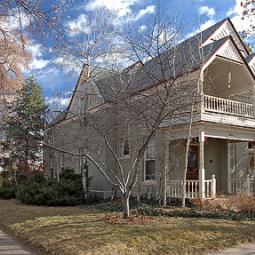Albert S. Whitaker was born in Tioga Co., NY, on August 22, 1844. He enlisted in the Army cavalry in 1861 and participated in multiple Civil War battles, including the Second Battle of Bull Run, Hay Market, Mechanicsville, Petersburg, and Richmond. After the war he was employed in railroad administration and later became secretary to Marcus “Brick” Pomeroy, an entrepreneur in railroading, journalism, and politics. He followed Pomeroy to Colorado in 1880, where the two men added mining and water development to their portfolios. They developed the Town of Highland on the hills overlooking Denver and secured its reputation as a residential Democratic stronghold, where Whitaker was elected mayor three times. As an officer of the Beaver Brook Water Company, which later folded into the Denver Water Company, Whitaker obtained one of the earliest water taps in the city in 1882 and built a Queen Anne house in 1891 on a half-acre property in the current Potter Highlands Historic District. Whitaker’s brother Sam, who subsequently had a long career in the Denver Fire Department, had an earlier house on an adjacent half acre. Brick Pomeroy’s grand mansion was a few blocks away on The Boulevard (now Federal Boulevard).
In the midst of many mining ventures in Clear Creek County, the Pomeroy/Whitaker partnership embarked on its greatest adventure, The Great Atlantic-Pacific Railroad Tunnel. With a great deal of fanfare, this bore under the Continental Divide at Gray’s Peak would have opened a direct rail line from Denver to the Pacific. It was expected to pay for itself by extracting gold along its five-mile length, and over 10,000 investors on both sides of the Atlantic put money into the project. Working from both sides, it was over one mile long when the Colorado economy suddenly collapsed in the Silver Panic of 1893, as did the fortunes of everyone involved in the A-P Tunnel. By 1896 Pomeroy was dead, Whitaker sold his property, and the Town of Highland was incorporated into the growing city of Denver. Whitaker worked for the US Mint for the rest of his life, and it wasn’t until over thirty years later that another railroad tycoon, David Moffat, succeeded in completing a train route under the Divide.
Other owners of the Whitaker house include George E. Armstrong, who later became President of the Bank of Denver, and Robert R. Janowski MD, who provided private primary health care to hundreds of people with AIDS during the initial two decades of the epidemic.




